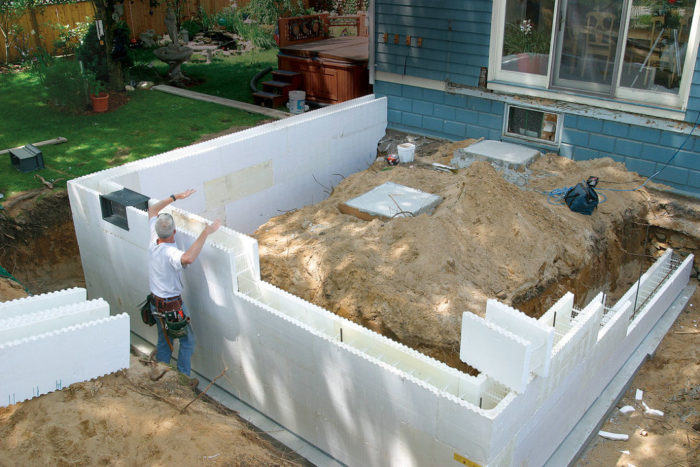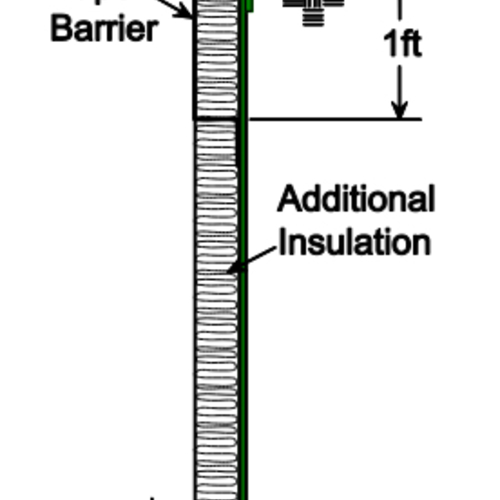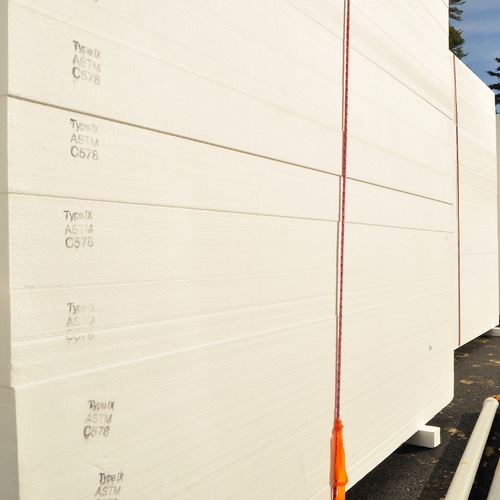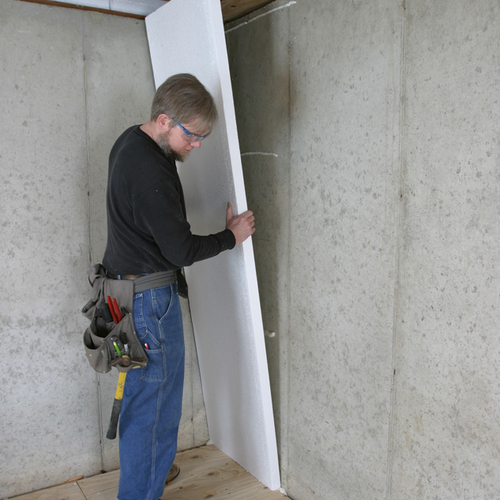
Peter Fusaro is building a high-efficiency house on spec, and his plans include insulating the foundation walls. The question is how.
One option is to apply rigid foam to the outside of the foundation. That would leave roughly 1 ft. of insulation above grade, and Fusaro is concerned about how durable the foam would be.
Another possibility is to use a sandwich of 2 in. of foam between two outer faces of concrete, each 4 in. thick, making an assembly with both structural and thermal properties. He’s been told a wall built that way would have an effective R-value of 19.27.
In a Q&A post at GreenBuildingAdvisor, Fusaro looks for advice. That’s the subject of this week’s Q&A Spotlight.
R-value is inflated
To GBA senior editor Martin Holladay, what Fusaro is describing sounds like the Thermomass Building Insulation System . These panels consist of Dow Styrofoam polystyrene insulation and two outer layers of concrete held together with a grid of fiber-composite fasteners. According to the company, the system is designed to minimize thermal bridging that would degrade the performance of the insulation.
The problem is that 2 in. of extruded polystyrene foam has an R-value of only 10. Concrete contributes very little thermal insulation to the assembly, so the R-19.27 Fusaro cites would seem to be little more than wishful thinking.
“The claim that the thermal mass of the concrete wall increases the effective R-value of the wall is false, although you hear it often,” Holladay writes.
“In some climates, especially with dependable nighttime temperatures below 72 degrees and dependable daytime temperatures above 72 degrees, walls with a lot of thermal mass can lower the energy used for heating or cooling. However, let’s not confuse thermal mass effects with R-value.
“In most parts of…
Weekly Newsletter
Get building science and energy efficiency advice, plus special offers, in your inbox.

This article is only available to GBA Prime Members
Sign up for a free trial and get instant access to this article as well as GBA’s complete library of premium articles and construction details.
Start Free TrialAlready a member? Log in















6 Comments
re
I dunno, but I have a different take on the ORNL report, it seems to point out 'significant' savings from thermal mass effects.
Martin as usual completely correct that mass does not increase r value. because r value is a static measurement. If it was exactly 20 degrees 24/7 all winter long, thermal mass [in a wall assembly] would be meaningless. The world however is dynamic, so a high mass wall really only has to fight the average over 'x' time rather than peak delta T, or so I would guess. The ORNL report link seems to call that worth at least 10 percent.
ICF and other manufacturers should not lie about R value. There is however value that can be expressed.
I think intuitively that it is easier to heat a brick structure than a tent, although they have similar r values.
Moisture management is 1st...
With basements is more important to have the best moisture barrier and details that the kind of insulation and where is installed. As long as R10-R15 min. is installed on the foundation wall (inside or outside) and under the slab, it makes small difference in energy efficiency; so it becomes an issue of budget, preference of insulation and workability. I would spend all my money and effort on the moisture management on the basement walls and slab.
Tongue-in-cheek effectiveness
Yesterday I was driving my car at 90 miles per hour! Okay, actually I was going 65 miles per hour, but it was into a 25 mph headwind, so my EFFECTIVE speed was 90 mph. So now what I can't figure out is why, if I was going 90 miles an hour, it still took me 2 hours to travel 130 miles.
I mean, yeah the ground was only passing under the car at 65 mph, but if my effective speed was 90mph, then I would think I would at least have averaged 77.5 mph after adding in the speed lag.
...Brilliant! :)
Foundation Insulation?
Surely we insulate to either keep warm or cool at lower cost, with the benefit of improved comfort?
Therefore my question is. Why insulate a crawl space when it is not used?
Surely the logic is to insulate as close to our comfort zone as possible?
With this in mind placing the insulation over the floor, as a floating floor and on the inside of the walls and ceilings, means using less insulation and saving years of costs heating the mass of the building.
Response to Roger Anthony
Roger,
There are lots of reasons to insulate a crawl space. Here in Vermont, insulating a crawl space is a necessity, not an option, because plumbing pipes will freeze if the builder forgets to insulate the crawl space.
In warm climates, builders often install ducts in a crawl space, so those crawl spaces need to be insulated to keep the ducts within the home's conditioned space.
There is one more reason to insulate and seal crawl spaces: in humid climates, vented crawl spaces don't work. They become soggy nightmares.
Log in or become a member to post a comment.
Sign up Log in